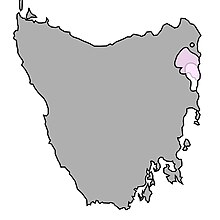Leucopatus
| Leucopatus | |
|---|---|

| |
| Scientific classification | |
| Domain: | Eukaryota |
| Kingdom: | Animalia |
| Phylum: | Onychophora |
| Family: | Peripatopsidae |
| Genus: | Leucopatus Oliveira, Ruhberg, Rowell & Mayer, 2018 |
| Species: | L. anophthalmus |
| Binomial name | |
| Leucopatus anophthalmus (Ruhberg, Mesibov, Briscoe & Tait, 1991) | |

| |
| Map of Tasmania with the distribution of Leucopatus anophthalmus in white. | |
| Synonyms | |
| |
Leucopatus is a genus of velvet worm in the family Peripatopsidae, containing a single species, the blind velvet worm (Leucopatus anophthalmus).[2][3][4] It is found in northeast Tasmania, Australia, and is ovoviviparous.[5]
The species was first described in 1991 as Tasmanipatus anophthalmus.[6][7]
Taxonomy
The generic name Leucopatus refers to the species' white colouration. The specific name anophthalmus refers to this species' lack of eyes.[8]
Description
The body is entirely white except for the tips of claws and jaws, which are dark brown. There are 15 pairs of oncopods. Adults are typically 25–30 mm long, but may extend to 50 mm while walking. Most distinctively, this species lacks eyes.[8] Typical habitat is beneath stones and rotten logs in sclerophyllous forests and shrubland.[9]
Conservation
Leucopatus anophthalmus is listed as Endangered on the IUCN Red List.[10]
References
- ^ New, T.R. (1996). "Tasmanipatus anophthalmus". IUCN Red List of Threatened Species. 1996. Retrieved 5 August 2007.
- ^ Oliveira, Ivo de Sena; Ruhberg, Hilke; Rowell, David M.; Mayer, Georg (2018-08-16). "Revision of Tasmanian viviparous velvet worms (Onychophora : Peripatopsidae) with descriptions of two new species". Invertebrate Systematics. 32 (4): 909–932. doi:10.1071/IS17096. ISSN 1447-2600. S2CID 91253450.
- ^ Oliveira, I.; Hering, L. & Mayer, G. "Updated Onychophora checklist". Onychophora Website. Retrieved 24 November 2016.
- ^ "Australian Faunal Directory". Australian Government Department of the Environment. Retrieved 29 June 2016.
- ^ Baker, Caitlin M; Buckman-Young, Rebecca S; Costa, Cristiano S; Giribet, Gonzalo (2021-12-09). Xia, Xuhua (ed.). "Phylogenomic Analysis of Velvet Worms (Onychophora) Uncovers an Evolutionary Radiation in the Neotropics". Molecular Biology and Evolution. 38 (12): 5391–5404. doi:10.1093/molbev/msab251. ISSN 1537-1719. PMC 8662635. PMID 34427671.
- ^ "Species Leucopatus anophthalmus (Ruhberg, Mesibov, Briscoe & Tait, 1991)". Australian Faunal Directory. Australian Government. Retrieved 2023-06-03.
- ^ Hilke Ruhberg; Robert Mesibov; D.A. Briscoe; N.N. Tait (1991). "Tasmanipatus barretti gen. nov., and T. anophthalmus, sp. nov.: two new and unusual Onychophorans (Onychophora : Peripatopsidae) from northeastern Tasmania" (PDF). Papers and Proceedings of the Royal Society of Tasmania. 125: 7-10 [9]. ISSN 0080-4703. Wikidata Q118793339.
- ^ a b Ruhberg, H.; Mesibov, R.; Briscoe, D. A.; Tait, N. N. (1991). "Tasmanipatus barretti gen. nov., sp. nov. and Tasmanipatus anophthalmus sp. no.: two new and unusual onychophorans (Onychophora: Peripatopsidae) from northeastern Tasmania". Papers and Proceedings of the Royal Society of Tasmania. 125: 7–10. doi:10.26749/rstpp.125.7.
- ^ "Australian Faunal Directory".
- ^ New, T.R. (1996). "Leucopatus anophthalmus". IUCN Red List of Threatened Species. 1996: e.T21501A9292041. doi:10.2305/IUCN.UK.1996.RLTS.T21501A9292041.en. Retrieved 12 November 2021.

